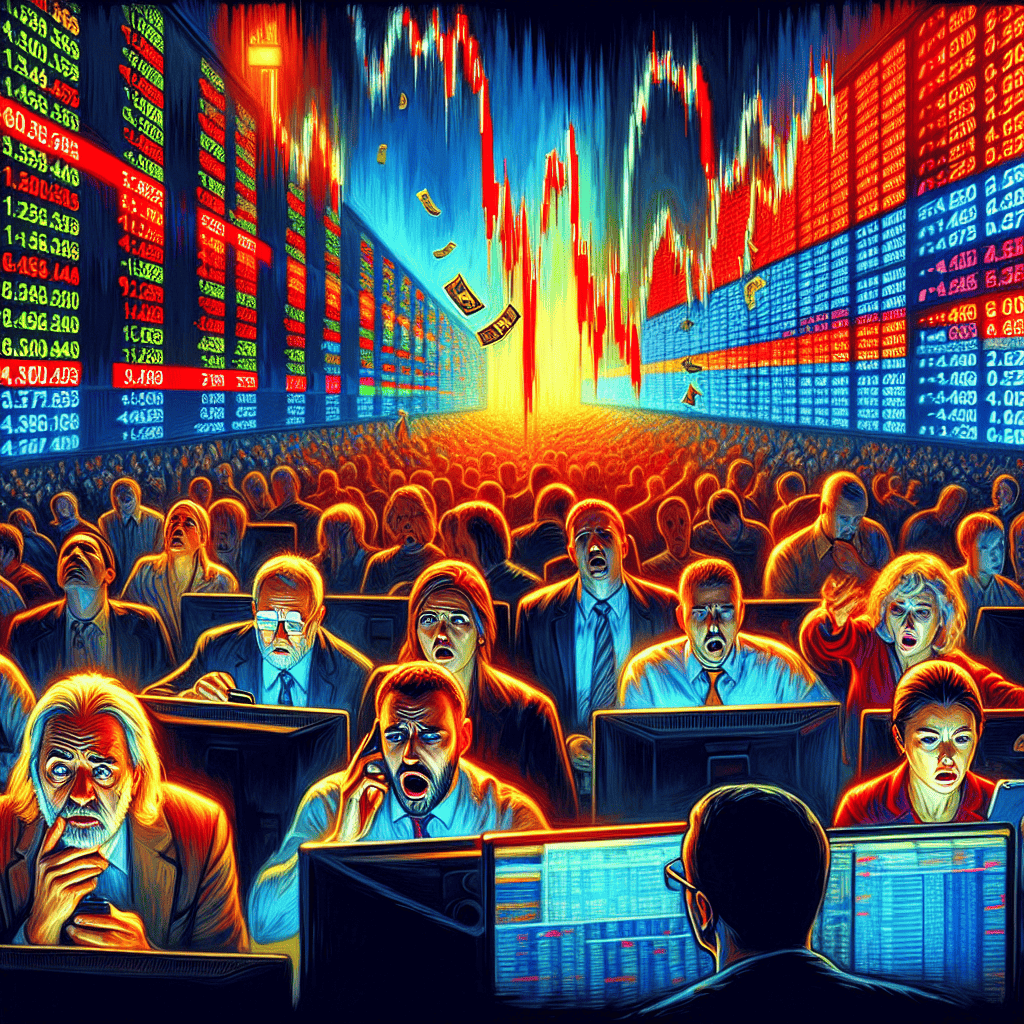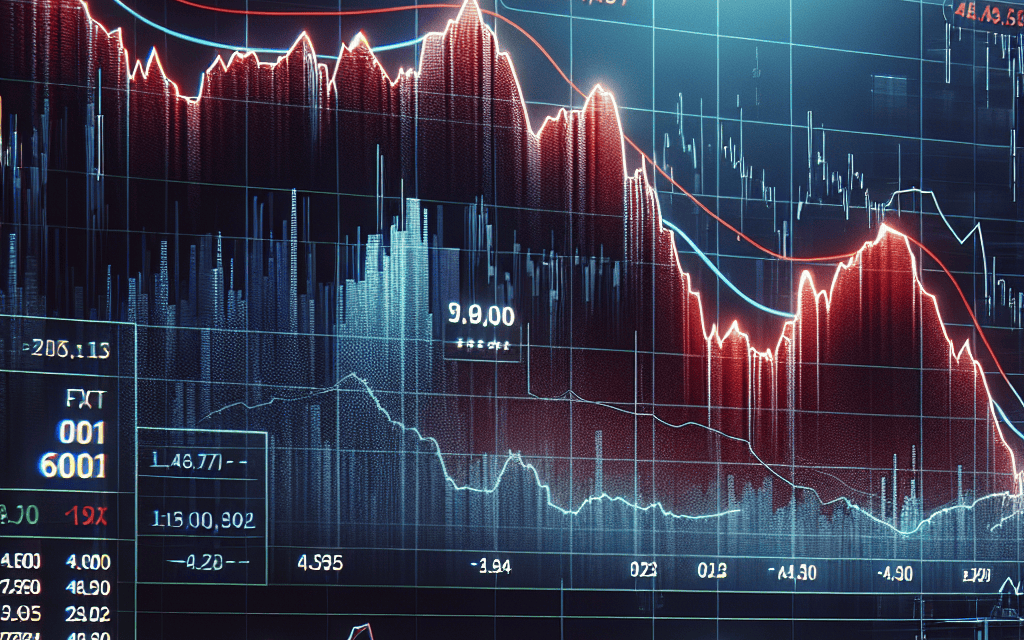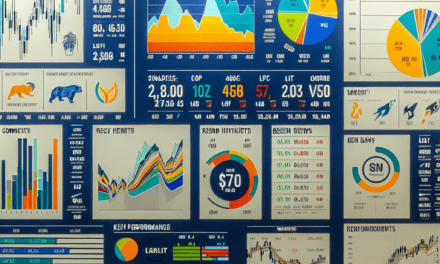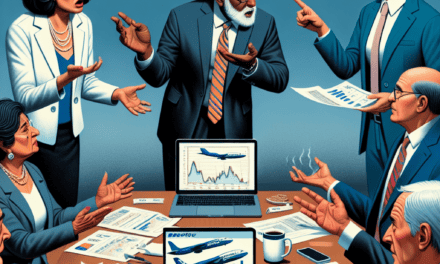“Market Tumbles: Dow Plunges Over 600 Points in a Month’s Steepest Decline”
Introduction
On a turbulent day for the financial markets, the Dow Jones Industrial Average plummeted over 600 points, marking its most significant single-day decline in a month. This sharp downturn reflects growing investor anxiety amid a confluence of economic pressures, including rising interest rates, geopolitical tensions, and concerns over corporate earnings. The sell-off underscores the volatility that has gripped global markets as traders grapple with uncertainty and recalibrate their strategies in response to evolving economic indicators. As the Dow faces its steepest drop in weeks, market participants are closely monitoring developments that could further influence the trajectory of the stock market in the coming days.
Market Volatility: Understanding the Causes Behind the Dow’s 600-Point Drop
The recent plunge in the Dow Jones Industrial Average, which saw a drop of over 600 points, marks its most significant decline in a month, leaving investors and analysts alike scrambling to understand the underlying causes. This sharp downturn in the market is a stark reminder of the inherent volatility that can characterize financial markets, even in periods of relative economic stability. To comprehend the factors contributing to this sudden drop, it is essential to consider a confluence of economic indicators, geopolitical tensions, and investor sentiment.
Firstly, economic indicators play a crucial role in shaping market movements. In recent weeks, there have been mixed signals regarding the health of the global economy. On one hand, certain sectors have shown resilience, with consumer spending and employment figures remaining robust. On the other hand, concerns about inflationary pressures have persisted, fueled by rising commodity prices and supply chain disruptions. These inflationary concerns have led to speculation about potential interest rate hikes by central banks, which can have a dampening effect on stock markets. Investors, wary of the impact of higher borrowing costs on corporate profits, may have reacted by pulling back from equities, contributing to the Dow’s decline.
In addition to economic indicators, geopolitical tensions have also played a significant role in unsettling the markets. Recent developments on the international stage, such as trade disputes and diplomatic conflicts, have heightened uncertainty. For instance, ongoing trade negotiations between major economies have been fraught with challenges, leading to fears of potential tariffs and trade barriers that could disrupt global commerce. Furthermore, geopolitical hotspots, such as tensions in the Middle East or Eastern Europe, can exacerbate market volatility by introducing elements of unpredictability. These geopolitical factors can lead to a risk-off sentiment among investors, prompting them to seek safer assets and thus contributing to the decline in stock indices like the Dow.
Moreover, investor sentiment is a critical component in understanding market dynamics. The stock market is not only a reflection of economic fundamentals but also a barometer of investor confidence. In times of uncertainty, even minor negative news can trigger significant market reactions. The recent drop in the Dow may have been exacerbated by a shift in investor sentiment, as market participants reassessed their risk tolerance in light of the aforementioned economic and geopolitical factors. The psychological aspect of investing cannot be underestimated, as fear and uncertainty can lead to herd behavior, where investors collectively move away from riskier assets, amplifying market declines.
In conclusion, the Dow’s 600-point drop can be attributed to a complex interplay of economic indicators, geopolitical tensions, and investor sentiment. While the market’s inherent volatility can be unsettling, it is important for investors to maintain a long-term perspective and avoid making impulsive decisions based on short-term fluctuations. Understanding the multifaceted nature of market movements can help investors navigate periods of volatility with greater confidence. As the global economic landscape continues to evolve, staying informed about the factors influencing market dynamics will be crucial for making sound investment decisions. By recognizing the interconnectedness of economic, geopolitical, and psychological factors, investors can better prepare for the challenges and opportunities that lie ahead in the ever-changing world of finance.
Investor Reactions: How Traders Are Responding to the Dow’s Worst Day in a Month
The recent plunge in the Dow Jones Industrial Average, which saw a drop of over 600 points, has sent ripples through the financial markets, marking its worst day in a month. This significant decline has prompted a variety of reactions from investors and traders, who are now navigating the turbulent waters of market volatility. As the Dow’s performance is often seen as a barometer of the broader economic landscape, its sharp fall has raised concerns about potential underlying issues that could be affecting the market.
In response to this downturn, traders are adopting a range of strategies to mitigate potential losses and capitalize on emerging opportunities. Some investors are opting for a cautious approach, choosing to hold onto their current positions and avoid making hasty decisions that could exacerbate their losses. This strategy is particularly prevalent among long-term investors who believe that the market will eventually recover, viewing the current dip as a temporary setback rather than a sign of a prolonged downturn.
Conversely, other traders are seizing the opportunity to buy stocks at lower prices, anticipating a rebound in the near future. This approach, often referred to as “buying the dip,” is based on the belief that the market’s fundamentals remain strong and that the recent decline is an overreaction to short-term factors. By purchasing stocks at a discount, these investors hope to benefit from potential gains when the market stabilizes and begins to climb once again.
Moreover, some investors are turning to alternative assets as a means of diversifying their portfolios and reducing exposure to market volatility. Gold, for instance, has historically been viewed as a safe haven during times of economic uncertainty, and its appeal has grown amid the recent market fluctuations. Similarly, cryptocurrencies, despite their inherent volatility, are attracting interest from traders seeking to hedge against traditional market risks.
In addition to these strategies, there is a growing emphasis on the importance of staying informed and adaptable in the face of market changes. Investors are increasingly relying on real-time data and analysis to guide their decision-making processes, recognizing that timely information can be crucial in navigating the complexities of the financial markets. This reliance on data-driven insights underscores the need for traders to remain vigilant and responsive to evolving market conditions.
Furthermore, the recent drop in the Dow has sparked discussions about the potential impact of external factors on the market’s performance. Concerns about geopolitical tensions, inflationary pressures, and shifts in monetary policy are among the issues that investors are closely monitoring, as these elements can significantly influence market dynamics. As such, traders are paying close attention to developments in these areas, seeking to anticipate how they might affect the market in the coming weeks and months.
In conclusion, the Dow’s worst day in a month has elicited a range of responses from investors, highlighting the diverse strategies employed to navigate market volatility. Whether adopting a cautious stance, capitalizing on lower stock prices, or diversifying into alternative assets, traders are actively seeking ways to manage risk and seize opportunities. As the market continues to evolve, the ability to remain informed and adaptable will be key to successfully navigating the challenges and opportunities that lie ahead.
Economic Indicators: Analyzing the Factors Contributing to the Dow’s Decline
The Dow Jones Industrial Average experienced a significant decline, dropping over 600 points, marking its worst day in a month. This downturn has raised concerns among investors and analysts, prompting a closer examination of the factors contributing to this sharp decline. To understand the underlying causes, it is essential to consider a combination of domestic and international economic indicators that have influenced market sentiment.
Firstly, rising inflationary pressures have been a persistent concern for the U.S. economy. Recent data indicating higher-than-expected inflation rates have fueled fears that the Federal Reserve may adopt a more aggressive stance on monetary policy. The prospect of increased interest rates to curb inflation can lead to higher borrowing costs for businesses and consumers, potentially slowing economic growth. Consequently, investors have become increasingly cautious, leading to a sell-off in equities, including those in the Dow Jones Industrial Average.
In addition to domestic inflation concerns, global economic uncertainties have also played a role in the Dow’s decline. The ongoing geopolitical tensions, particularly in Eastern Europe and the Middle East, have contributed to market volatility. These tensions have the potential to disrupt global supply chains and energy markets, further exacerbating inflationary pressures. As a result, investors are wary of the potential impact on corporate earnings and economic stability, prompting a shift away from riskier assets.
Moreover, recent corporate earnings reports have been a mixed bag, adding to the uncertainty in the market. While some companies have reported robust earnings, others have issued warnings about future profitability due to rising input costs and supply chain disruptions. This inconsistency in earnings performance has led to increased volatility in stock prices, as investors reassess their portfolios in light of these developments. The Dow, being a price-weighted index, is particularly sensitive to fluctuations in the stock prices of its constituent companies, amplifying the impact of these earnings reports on the overall index.
Furthermore, the labor market has shown signs of cooling, with recent employment data indicating slower job growth than anticipated. While a tight labor market can lead to wage inflation, a slowdown in job creation may signal weakening economic momentum. This duality presents a challenge for policymakers and investors alike, as they attempt to balance the need for economic growth with the risks of overheating. The uncertainty surrounding the labor market’s trajectory has added another layer of complexity to the investment landscape, contributing to the Dow’s decline.
In light of these factors, it is evident that the Dow’s recent drop is not attributable to a single cause but rather a confluence of economic indicators and market dynamics. As investors navigate this challenging environment, they must remain vigilant and adaptable, considering both short-term fluctuations and long-term trends. While the current situation may seem daunting, it is important to remember that market corrections are a natural part of the economic cycle. By maintaining a diversified portfolio and staying informed about economic developments, investors can better position themselves to weather the storm and capitalize on future opportunities.
In conclusion, the Dow’s decline of over 600 points underscores the complex interplay of domestic and international factors influencing market sentiment. Rising inflation, geopolitical tensions, mixed corporate earnings, and labor market uncertainties have all contributed to this downturn. As the economic landscape continues to evolve, investors must remain attentive to these indicators, adapting their strategies to navigate the challenges and opportunities that lie ahead.
Historical Context: Comparing the Recent Dow Drop to Past Market Downturns

The recent plunge of over 600 points in the Dow Jones Industrial Average has captured the attention of investors and analysts alike, marking its worst day in a month. To understand the implications of this decline, it is essential to place it within a historical context, comparing it to past market downturns. By doing so, we can gain insights into the potential causes and consequences of such market behavior, as well as the broader economic environment that influences these fluctuations.
Historically, the Dow has experienced numerous significant drops, each with its own set of catalysts and repercussions. For instance, the stock market crash of 1929, which heralded the onset of the Great Depression, was characterized by a series of precipitous declines that wiped out substantial wealth and led to widespread economic hardship. Similarly, the financial crisis of 2008 saw the Dow plummet as the collapse of major financial institutions and the bursting of the housing bubble triggered a global recession. These historical downturns were marked by systemic issues within the financial system, leading to long-lasting economic impacts.
In contrast, the recent 600-point drop, while significant, does not yet appear to signal a crisis of similar magnitude. Instead, it may be more akin to other short-term corrections that the market has experienced over the years. For example, the market correction in early 2018, which saw the Dow fall by over 1,000 points in a single day, was largely attributed to concerns over rising interest rates and inflation. Such corrections, while unsettling, are often part of the market’s natural ebb and flow, reflecting investor sentiment and external economic factors.
To further contextualize the recent decline, it is important to consider the current economic landscape. The global economy is navigating a complex set of challenges, including geopolitical tensions, supply chain disruptions, and inflationary pressures. These factors contribute to market volatility, as investors react to new information and adjust their expectations accordingly. Moreover, the Federal Reserve’s monetary policy decisions, particularly regarding interest rates, play a crucial role in shaping market dynamics. As the Fed signals its intentions to combat inflation, investors may recalibrate their portfolios, leading to fluctuations in stock prices.
While the recent drop in the Dow is noteworthy, it is essential to recognize that the stock market is inherently volatile, with fluctuations driven by a myriad of factors. Historical comparisons can provide valuable perspective, highlighting that while some downturns have been precursors to broader economic challenges, others have been temporary corrections that ultimately gave way to recovery and growth. Investors and analysts must therefore remain vigilant, considering both historical precedents and current economic conditions as they navigate the complexities of the market.
In conclusion, the Dow’s recent decline of over 600 points serves as a reminder of the market’s inherent volatility and the myriad factors that can influence its trajectory. By examining historical downturns and considering the current economic environment, we can better understand the potential implications of such fluctuations. While it is impossible to predict the future with certainty, a nuanced understanding of both past and present market dynamics can help investors make informed decisions in the face of uncertainty.
Sector Impact: Which Industries Are Most Affected by the Dow’s Plunge?
The recent plunge of over 600 points in the Dow Jones Industrial Average has sent ripples of concern across various sectors, marking its worst day in a month. This significant drop has not only rattled investors but also raised questions about which industries are most vulnerable to such market volatility. As the Dow serves as a barometer for the overall health of the U.S. economy, its fluctuations can have far-reaching implications for different sectors. Understanding these impacts is crucial for stakeholders aiming to navigate the turbulent financial landscape.
To begin with, the technology sector often finds itself at the forefront of market fluctuations. Given its substantial representation in major indices, any downturn in the market tends to disproportionately affect tech stocks. Companies in this sector, characterized by high valuations and growth expectations, are particularly sensitive to changes in investor sentiment. As interest rates rise or economic uncertainties loom, investors may shy away from tech stocks, seeking refuge in more stable, value-oriented investments. Consequently, the recent drop in the Dow has seen tech giants experiencing notable declines, reflecting broader concerns about future growth prospects and profitability.
In addition to technology, the financial sector is another area significantly impacted by the Dow’s recent decline. Banks and financial institutions are closely tied to economic cycles, and their performance is often a reflection of broader economic conditions. When the market experiences a downturn, it can lead to reduced consumer confidence and spending, which in turn affects loan demand and financial services. Moreover, fluctuations in interest rates, often a response to market conditions, can impact banks’ net interest margins, further influencing their profitability. As a result, the financial sector tends to react swiftly to changes in the Dow, with investors reassessing their positions based on anticipated economic shifts.
Furthermore, the industrial sector, which includes companies involved in manufacturing and production, is also susceptible to market downturns. This sector is heavily reliant on global trade and economic stability, making it vulnerable to geopolitical tensions and supply chain disruptions. A significant drop in the Dow can exacerbate these challenges, as companies may face reduced demand for their products and increased costs. Consequently, industrial stocks often experience heightened volatility during periods of market stress, as investors weigh the potential impact on earnings and growth.
Moreover, consumer discretionary stocks, which encompass industries such as retail, travel, and leisure, are particularly sensitive to changes in consumer confidence and spending. A sharp decline in the Dow can signal economic uncertainty, prompting consumers to tighten their belts and reduce discretionary spending. This shift can have a direct impact on companies within this sector, leading to lower revenues and profitability. As a result, consumer discretionary stocks often bear the brunt of market downturns, reflecting broader concerns about economic resilience and consumer behavior.
In contrast, some sectors may exhibit relative resilience in the face of market volatility. For instance, the utilities and consumer staples sectors, often considered defensive plays, tend to perform better during downturns. These industries provide essential goods and services that remain in demand regardless of economic conditions, offering a degree of stability for investors seeking to mitigate risk.
In conclusion, the recent 600-point drop in the Dow has underscored the varying impacts on different sectors, highlighting the interconnectedness of the market and the economy. While technology, financials, industrials, and consumer discretionary stocks face heightened vulnerability, defensive sectors like utilities and consumer staples may offer a safe haven. As investors navigate these challenging times, understanding sector-specific dynamics will be crucial in making informed decisions and managing risk effectively.
Future Outlook: What the Dow’s Recent Performance Means for Investors
The recent plunge in the Dow Jones Industrial Average, which saw a drop of over 600 points, marks its worst day in a month and has left investors grappling with uncertainty. This significant decline has raised questions about the future outlook of the market and what it means for investors moving forward. As the Dow’s performance often serves as a barometer for the broader economy, understanding the factors contributing to this downturn is crucial for making informed investment decisions.
To begin with, the recent drop in the Dow can be attributed to a confluence of factors, including rising inflation concerns, geopolitical tensions, and fluctuating interest rates. Inflation, in particular, has been a persistent worry for investors, as it erodes purchasing power and can lead to higher costs for businesses. The Federal Reserve’s stance on interest rates has also been a focal point, with investors closely monitoring any signals of potential rate hikes. Such increases could dampen economic growth by making borrowing more expensive, thereby impacting corporate profits and, consequently, stock prices.
Moreover, geopolitical tensions have added another layer of complexity to the market’s outlook. Ongoing conflicts and trade disputes can disrupt global supply chains and create an environment of uncertainty, which often leads to market volatility. Investors tend to react to these uncertainties by pulling back from riskier assets, contributing to declines in major indices like the Dow.
In light of these challenges, investors are advised to adopt a cautious approach. Diversification remains a key strategy, as it helps mitigate risks by spreading investments across various asset classes. By doing so, investors can potentially offset losses in one area with gains in another, thereby stabilizing their portfolios. Additionally, maintaining a long-term perspective is essential. While short-term market fluctuations can be unsettling, history has shown that markets tend to recover over time. Therefore, staying focused on long-term goals rather than reacting impulsively to daily market movements can be beneficial.
Furthermore, it is important for investors to stay informed about economic indicators and market trends. Keeping abreast of developments in inflation rates, employment figures, and corporate earnings can provide valuable insights into the market’s direction. This knowledge can empower investors to make more strategic decisions, whether it involves adjusting their asset allocation or identifying new investment opportunities.
In conclusion, the recent drop in the Dow Jones Industrial Average serves as a reminder of the inherent volatility in financial markets. While the current environment presents challenges, it also offers opportunities for those who are prepared to navigate the complexities. By employing strategies such as diversification, maintaining a long-term outlook, and staying informed, investors can better position themselves to weather the storm and potentially capitalize on future market recoveries. As always, consulting with financial advisors and conducting thorough research are prudent steps to ensure that investment decisions align with individual risk tolerance and financial objectives.
Risk Management: Strategies for Navigating Market Turbulence After a Major Dow Drop
In the wake of a significant market downturn, such as the recent drop of over 600 points in the Dow Jones Industrial Average, investors are often left grappling with uncertainty and concern. This decline, marking the worst day for the index in a month, underscores the inherent volatility of financial markets and the importance of effective risk management strategies. As market participants navigate these turbulent waters, it becomes crucial to adopt a comprehensive approach to mitigate potential losses and safeguard investments.
To begin with, diversification remains a cornerstone of risk management. By spreading investments across various asset classes, sectors, and geographic regions, investors can reduce the impact of a downturn in any single area. This strategy not only helps in cushioning the blow from market volatility but also provides opportunities for growth in other segments that may perform well despite broader market declines. For instance, while equities may suffer during a market drop, bonds or commodities might offer stability or even gains, thereby balancing the overall portfolio performance.
In addition to diversification, maintaining a long-term perspective is essential. Market fluctuations, while unsettling, are a natural part of the investment landscape. Historical data suggests that markets tend to recover over time, rewarding those who remain patient and committed to their investment strategy. By focusing on long-term goals rather than short-term market movements, investors can avoid making impulsive decisions that may lead to unnecessary losses. This approach requires discipline and a clear understanding of one’s financial objectives, risk tolerance, and time horizon.
Moreover, employing stop-loss orders can serve as an effective tool for managing risk. These orders automatically sell a security when it reaches a predetermined price, thereby limiting potential losses. While stop-loss orders do not guarantee protection against all losses, they can help investors avoid significant declines by exiting positions before they worsen. It is important, however, to set these orders thoughtfully, considering the volatility of the asset and the investor’s risk appetite.
Furthermore, staying informed about market conditions and economic indicators is vital for making informed decisions. Regularly reviewing financial news, analyst reports, and economic data can provide valuable insights into potential market trends and risks. This knowledge enables investors to adjust their strategies proactively, rather than reacting to market events after they occur. Engaging with financial advisors or investment professionals can also offer guidance tailored to individual circumstances, helping investors navigate complex market environments.
Additionally, maintaining liquidity within a portfolio is crucial during periods of market turbulence. Having access to cash or cash-equivalent assets allows investors to take advantage of buying opportunities that may arise during market downturns. It also provides a buffer to meet any immediate financial needs without the necessity of selling investments at a loss. This flexibility can be a significant advantage in managing risk and capitalizing on market volatility.
In conclusion, while a major drop in the Dow Jones Industrial Average can be unsettling, it also serves as a reminder of the importance of robust risk management strategies. By diversifying investments, maintaining a long-term perspective, utilizing stop-loss orders, staying informed, and ensuring liquidity, investors can better navigate the challenges posed by market turbulence. These strategies not only help in mitigating potential losses but also position investors to seize opportunities that may arise in the aftermath of a market decline.
Q&A
1. **What caused the Dow to drop over 600 points?**
Economic concerns, such as inflation fears, interest rate hikes, or geopolitical tensions, often lead to significant market declines.
2. **When did the Dow experience this drop?**
The specific date would be needed, but such drops typically occur during trading hours on a weekday.
3. **How does a 600-point drop compare to previous market declines?**
A 600-point drop is significant but not unprecedented; it depends on the Dow’s overall level at the time.
4. **What sectors were most affected by the Dow’s decline?**
Typically, sectors like technology, financials, or consumer goods might be heavily impacted during such drops.
5. **How did other major indices perform on the same day?**
Other indices like the S&P 500 and Nasdaq often experience similar declines during major market downturns.
6. **What are analysts predicting following this drop?**
Analysts might predict continued volatility, potential recovery, or further declines based on economic indicators.
7. **What should investors consider during such market drops?**
Investors are often advised to stay calm, review their portfolios, and consider long-term strategies rather than making impulsive decisions.
Conclusion
The Dow Jones Industrial Average experienced a significant decline, dropping over 600 points, marking its worst day in a month. This downturn reflects heightened investor concerns, potentially driven by a combination of factors such as economic data releases, geopolitical tensions, or shifts in monetary policy expectations. The substantial drop underscores the market’s volatility and sensitivity to external influences, highlighting the importance for investors to remain vigilant and informed about ongoing economic developments.





